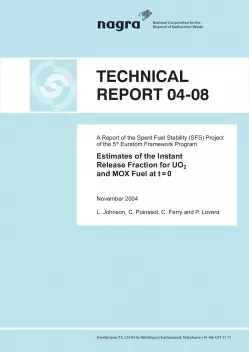
Technical Report NTB 04-08
A report of the Spent Fuel Stability (SFS) Project of the 5th Euratom Framework Program:Estimates of the Instant Release Fraction for UO2 and MOX Fuelat t = 0.
The EU Spent Fuel Stability Project (SFS) aims to develop a model predicting the radionuclide release rate from spent fuel as a function of time for geological disposal conditions. Work Package 1 (WP1) of SFS is an important aspect of this model develop-ment as it is focused on defining the instant release fraction (IRF), which represents the fraction of the inventory of safety-relevant radionuclides that may be rapidly released from the fuel and fuel assembly materials at the time of canister breaching. The locations of these preferentially released radionuclides, their quantities, the evidence for their release and proposed estimates of the IRF for the key safety-relevant radionuclides for the case of fuel shortly after discharge from the reactor (t = 0) are the subjects of the present report. The potential evolution of the IRF with time in an unbreached canister due to solid-state processes such as diffusion to grain boundaries (alpha self-irradiation enhanced diffusion (αSIED)) or free surfaces has been treated in a separate study (Lovera et al. 2003). These two studies, along with an assessment of the issue of grain boundary stability over time, will ultimately be combined into a comprehensive evaluation of the IRF and combined with the MAM (matrix alteration model) of WP4 in an integrated assessment in WP5 of the project.
Spent fuel assemblies comprise several materials, including uranium oxide, Zircaloy and various steels or nickel alloys used in the structural components of fuel assemblies. Information on the distribution of both activation products and fission products in all these materials must be taken into account in deriving IRF values. The following sections present information on the radionuclide distributions in the various materials and propose IRF values for key radionuclides. The information in this report is based on the recent study of Johnson and McGinnes (2002), combined with additional data on fission gas release of both UO2 and MOX fuel, as well as new data on leaching of cesium, all provided by the CEA. The radionuclide concentrations in the various fuel assembly materials are not addressed in the present report.
